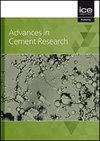Utilizing under burnt waste bricks from kilns as supplementary cementitious material
IF 1.3
4区 工程技术
Q3 CONSTRUCTION & BUILDING TECHNOLOGY
引用次数: 2
Abstract
This paper studies the pozzolanic performance of Crushed Brick Powder (CBP) obtained by grounding under- burnt waste bricks from a continuous brick kiln. Two different size fractions of CBP considered for cement replacement are CBP1 passing through 150 μm but retained on 75 μm and CBP 2 passing through 75μm. The compressive strength tests on mortar with CBP reveal that strength does not exceed the control; however, 10 - 15% cement replacement by CBP is optimum. A study of the presence of hydrate phases by XRD and quantification of portlandite in the paste samples by TGA up to 90 days confirms the action of pozzolanicity. Further, To determine the feasibility of CBP1 and CBP2 fractions in concrete, M25 grade concrete's strength and carbonation were studied by replacing 45% cement with a combined proportion of CBP1 (20%) and CBP2 (25%). This replacement reduced the concrete grade from M25 to M20 and increased the accelerated carbonation depth. Despite this, the projected natural carbonation coefficient with accelerated carbonation data is determined as low. The utilised CBP is cost-effective as it requires less mechanical processing and is without any chemical activation, and thus it can satisfactorily be used for low-cost housing construction and lower-grade structural and non-structural uses.利用窑炉烧成不足的废砖作为辅助胶凝材料
研究了连续式砖窑烧成不足的废砖经煅烧后得到的碎砖粉(CBP)的火山灰性能。考虑用于水泥置换的CBP的两种不同尺寸组分是通过150μm但保留在75μm上的CBP1和通过75μm的CBP2。用CBP对砂浆进行抗压强度试验,结果表明强度未超过对照;而CBP水泥替代率为10-15%是最佳的。通过XRD对水合物相的存在进行研究,并通过TGA对糊状物样品中的硅酸盐进行定量长达90天,证实了火山灰的作用。此外,为了确定CBP1和CBP2在混凝土中的可行性,通过用CBP1(20%)和CBP2(25%)的组合比例代替45%的水泥,研究了M25级混凝土的强度和碳化作用。这种替换将混凝土等级从M25降低到M20,并增加了加速碳化深度。尽管如此,具有加速碳酸化数据的预测自然碳酸化系数被确定为较低。所使用的CBP具有成本效益,因为它需要较少的机械加工,并且没有任何化学活化,因此它可以令人满意地用于低成本的住房建设以及较低级别的结构和非结构用途。
本文章由计算机程序翻译,如有差异,请以英文原文为准。
求助全文
约1分钟内获得全文
求助全文
来源期刊

Advances in Cement Research
工程技术-材料科学:综合
CiteScore
3.70
自引率
5.00%
发文量
56
审稿时长
3.2 months
期刊介绍:
Advances in Cement Research highlights the scientific ideas and innovations within the cutting-edge cement manufacture industry. It is a global journal with a scope encompassing cement manufacture and materials, properties and durability of cementitious materials and systems, hydration, interaction of cement with other materials, analysis and testing, special cements and applications.
 求助内容:
求助内容: 应助结果提醒方式:
应助结果提醒方式:


